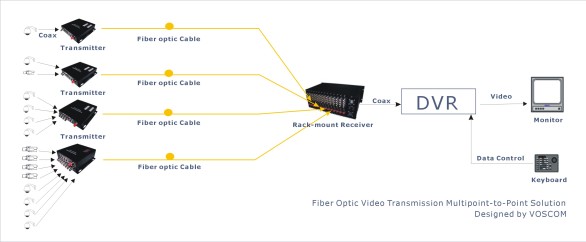An fiber optic transmitter converts electrical input signals into modulated light for transmission over a fiber optic cable. Depending on the nature of the signal, the resulting modulated light may be turned on and off or may be linearly varied in intensity between two predetermined levels. Figure (2) shows a representation of these two basic schemes.


The devices used as the light sources in optical transmitters are Light Emitting Diode (LED) and Laser Diodes. LEDs and Lasers are semiconductors mounted in a TO style can or microlens package that focus the beam of light right into the optical fiber connector. In the case of analog FM transmission, the Laser is “pigtailed” directly onto the surface of the emitter in order to reduce or eliminate back reflection and noise.
LEDs have a wide spectral frequency, are suited for large aperture multimode fibers and are used for short to moderate transmission distances. Lasers, on the other hand, feature a narrow band of wavelengths and can couple many times more power into the fiber than LEDs and therefore are useful in applications that require high speed, high bandwidth over long distances. Lasers are not stable over wide operating temperatures, however, with well-designed feedback circuitry, continuous stable output can be achieved.

Analog modulation takes a number of forms – see figure (3). The simplest is intensity modulation (IM) where the brightness of an LED is varied in direct step with the variations of the transmitted signal. In other methods, an RF carrier is first frequency modulated (FM) with another signal or, in some cases, several RF carriers are separately modulated, then are combined and transmitted as one complex waveform.
Fiber Optic Receivers
The fiber optic receiver converts modulated light coming from an optical fiber back into the original electronic signal applied to the transmitter.
The detector is a photodiode of either the PIN or the Avalanche type and is mounted in a similar package to the one used for the LED or Laser. Sensitivity of the receiver is specified as the minimum signal that it can receive (in dBm). Dynamic Range is the difference between the minimum and maximum acceptance levels. Receivers usually employ high gain internal amplifiers and require special circuitry to avoid saturation or distortion. When the optical dynamic range of the system is equal to the optical power budget, no saturation of the receiver can occur. Quality of signal transmission is equally good at short or long distances.
As in the case of fiber optc transmitters, fiber optic receivers are available in both analog and digital versions. Figure (4) is a functional diagram of a simple analog optical receiver.


